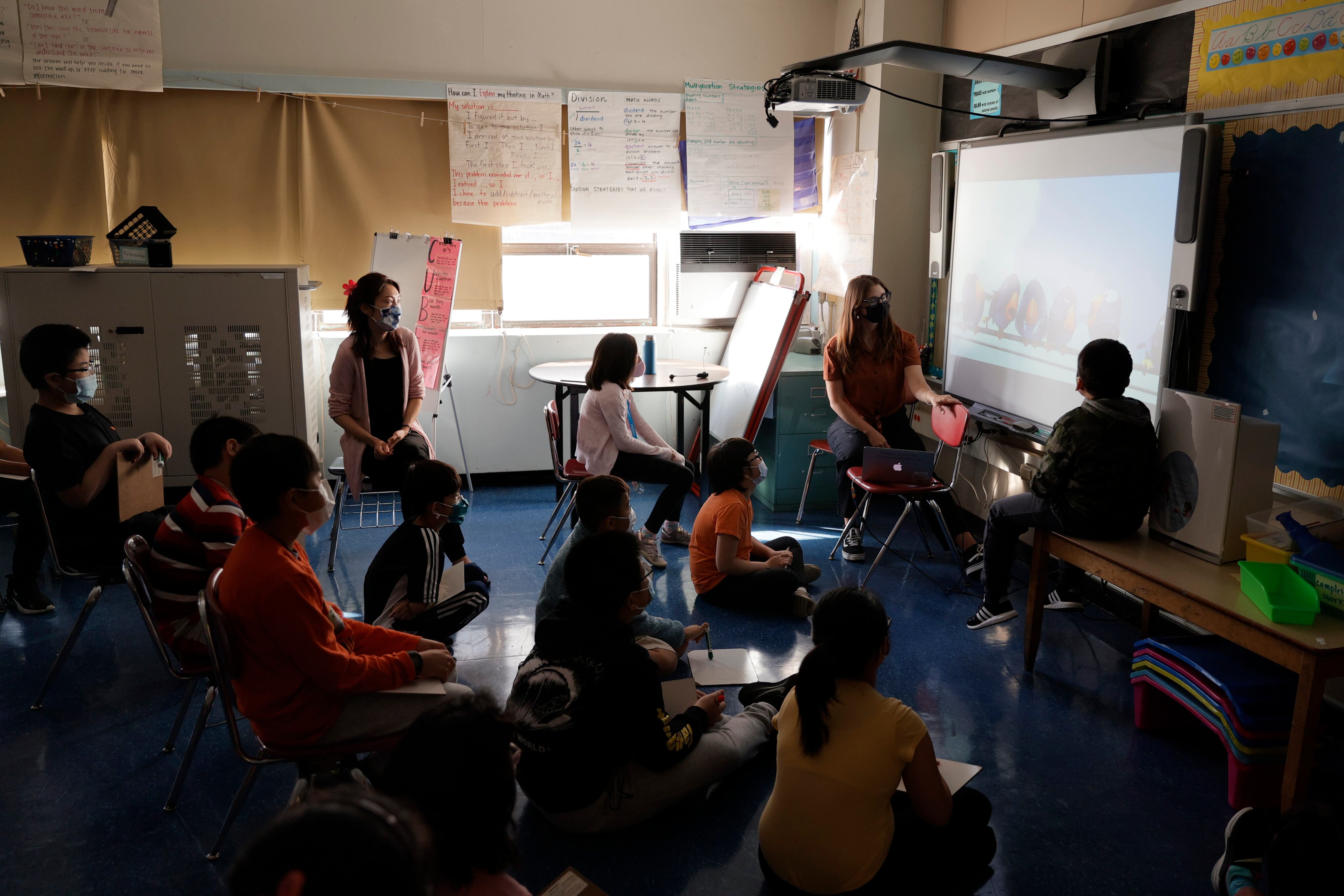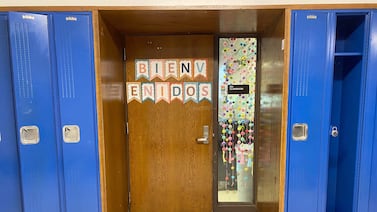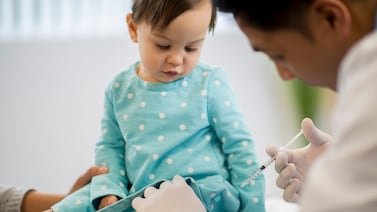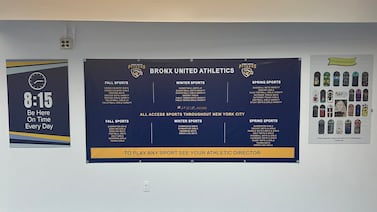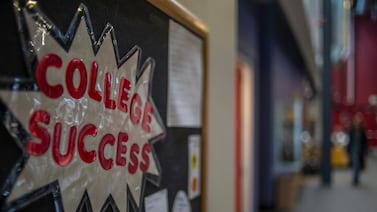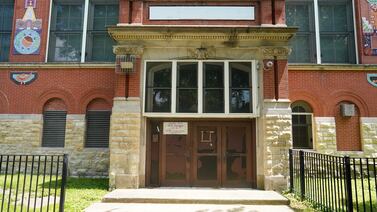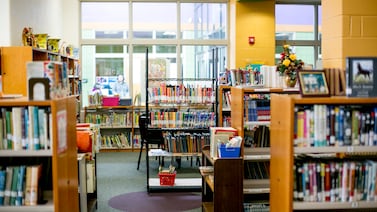At one school in the Bronx, students will eat in their classrooms because there isn’t enough staff to supervise the lunchroom — almost 20% of employees are either sick with COVID-19, or showing symptoms and trying to get tested, according to an assistant principal there.
In at least three schools in Lower Manhattan and Brooklyn, administrators decided to pivot to remote learning after a dozen people at each of their campuses tested positive, giving students the option to come into the building to log in to their classes if they can’t stay home.
And one elementary school in Queens told entire classes to stay home, despite city guidance that only close contacts have to quarantine, because it was taking too long to report and confirm positive cases through the official channels.
As coronavirus cases spike in New York City, school leaders are taking matters into their own hands to respond to positive cases and staffing shortages within their communities. Calls are also rising to increase COVID testing within schools, as citywide more than 20% of students were absent and some campuses saw even sharper declines in attendance. Some schools are even encouraging students to stay home by offering excused absences and access to remote work.
The mounting cases coincide with a short week: schools close for winter break on Dec. 24. By the time students and staff return, it will be up to a new mayor to decide the safety and health policies for the nation’s largest school district. Mayor-elect Eric Adams takes office Jan. 1 and classes resume just two days later.
Officials with his campaign did not respond to comment. The incoming chancellor, David Banks, declined to comment.
Test to stay?
Gov. Kathy Hochul, meanwhile, announced that 2 million at-home tests are on their way to schools across the state, part of a strategy to help districts implement new quarantine measures referred to as “test-to-stay” after the winter break. The Centers for Disease Control and Prevention recently endorsed the approach, which allows students to stay in school after potential exposure to the coronavirus, as long as they are frequently tested.
Hochul also said she wants schools to accept rapid test results to return to classes. In New York City, some educators have balked for a different reason, saying that the education department won’t acknowledge positive results from at-home tests, even at a time when some New Yorkers are spending hours waiting in line for a lab test.
Incoming New York City Comptroller Brad Lander on Monday called on the city to require a negative COVID test from students and staff after the winter break. He said the city should give school communities priority access to testing ahead of the return to classes, and send rapid tests to schools to have on-hand for anyone who isn’t able to get swabbed.
Chicago recently took a similar approach, mailing at-home tests to students, but there’s no requirement to show a negative test to return to class.
Outgoing Mayor Bill de Blasio on Monday stuck to his message that schools are safe and did not outline any additional steps the city would take to address mounting cases for the remaining days that schools are in session and under his watch.
“We’re dealing with a temporary phenomenon. We have tremendous tools to deal with it because school communities have been so safe,” he said at a press conference.
De Blasio has promised to ramp up staffing in the city’s Situation Room, an interagency response team that handles testing and contact tracing of cases among school communities. Education department officials did not answer questions about the current Situation Room staffing levels, only saying that it has begun to double, to more than 500. Also in response to the backlogs, the education department has given principals more leeway to make their own quarantine decisions.
School leaders on Monday said there are still major delays in response times, or even just being able to report positive cases.
There were seven schools closed and another 45 under investigation as of Dec. 20.
Cases rise, schools scramble
In the meantime, schools have begun to act on their own.
Leaders from the Brooklyn New School, a progressive elementary school in Carroll Gardens, sent an email to families on Sunday night about the “concerning” increase in cases over the past 72 hours, and said they were having challenges reaching the Situation Room to communicate about new positive cases among staff members and students.
The school was working hard to make sure to notify close contacts as soon as possible, but said, “It seems that each time we complete the notifications for one case, we hear of another,” the email said.
As several classrooms had to pivot to remote learning over the weekend, several families expressed concerns about sending their children to school.
“If you wish to keep your child at home as a health and safety precaution, please notify your child’s teacher,” the email said. “We must consider safety first right now.”
Later that evening, Shane Aslan Selzer got an email from her third grader’s teachers saying that the Brooklyn New School would be able to offer in-person and remote options for all families this week.
Acknowledging that the rising cases were “troubling,” Selzer didn’t hesitate to send her child, who had two doses of the COVID vaccine and will be considered fully vaccinated by Tuesday. She worried that a teacher might not be leading her son’s class.
“I want educational opportunities for my child,” she said “We’re in the third academic year of this affecting our kids. I’m not willing to go back to the March 2020 mentality. We’ve learned a lot since then, haven’t we?”
Science teacher Mike Stivers spent Monday morning handing out fliers in front of his school, Millennium Brooklyn High School in Park Slope, calling on the city to scale up access to COVID testing.
His school is under investigation for a possible outbreak after a number of positive cases there, but Stivers said most of them were detected by tests taken out of school. Teachers from his campus, which also includes Cyberarts Studio Academy and Park Slope Collegiate, signed an open letter demanding in-school testing for anyone who has been in close contact with someone who has tested positive, and for random testing conducted on schools to begin to include vaccinated students and staff.
“We want schools to be open but obviously we want them to be safe, too,” Stivers said. “I think there is a broad sentiment that the testing is not enough.”
While cases mount, many families have decided to keep their children home. One assistant principal in Brooklyn, who asked not to be named so that she could speak freely, said that about 130 students out of 500 were quarantined. Only about 120 showed up in-person for classes on Monday.
The citywide attendance rate was 79%, down by nearly 10 percentage points from last week’s average.
The Brooklyn assistant principal said the school marks students as present, even if they’re out because of health concerns, because families might otherwise run the risk of involvement with the Administration for Children’s Services, which investigates parental abuse or neglect. The education department has promised to work with families who remain fearful of the virus, but some have reported being investigated by ACS for keeping their children home.
The assistant principal said she was “really angry that we’re back in this position.”
“I kept my own kid home this week. Not worth the risk,” she said.


